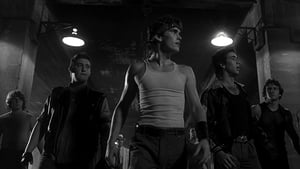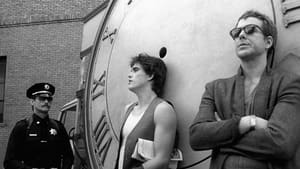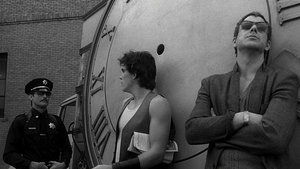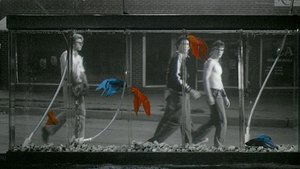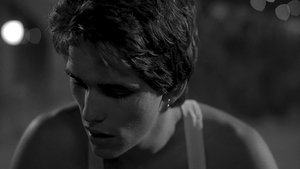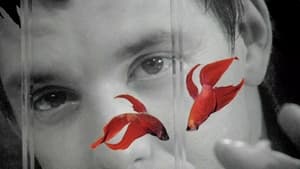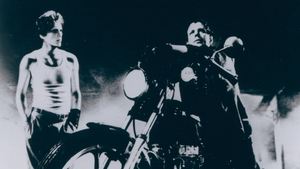Contact: info@alwanfilm.com
Video Sources 0 Views
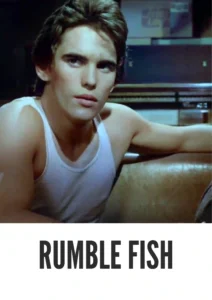
Synopsis
Review: Rumble Fish 1983 Colorized – A Journey Through Time and Shadows

Introduction
“Rumble Fish,” released in 1983, is a cinematic gem directed by Francis Ford Coppola, known for its distinctive visual style and evocative storytelling. This film, based on the novel by S.E. Hinton, has gained a cult following for its exploration of youth, identity, and the inevitability of time. Shot in stark black and white with occasional splashes of color, “Rumble Fish” offers a unique viewing experience that delves deep into the psyche of its characters. In this article, we will explore the film’s artistic choices, its impact on the audience, and its place in the pantheon of great American cinema.
Check The Full Colorized Movies List
Check Our Colorized Movies Trailer Channel
Understanding Rumble Fish 1983 Colorized: Director, Cast, and Genre
“Rumble Fish 1983” is the brainchild of Francis Ford Coppola, a director whose name is synonymous with cinematic excellence. Coming off the success of “The Godfather” series and “Apocalypse Now,” Coppola took a sharp turn with “Rumble Fish,” opting for a more experimental approach. The film stars Matt Dillon as Rusty James, a troubled youth trying to live up to the legacy of his older brother, the Motorcycle Boy, played by Mickey Rourke. Supporting roles are filled by an impressive cast, including Diane Lane, Dennis Hopper, Nicolas Cage, and Laurence Fishburne.
The film can be classified as a drama, but it transcends traditional genre boundaries with its avant-garde techniques and deep philosophical underpinnings. “Rumble Fish” is less about action and more about mood, atmosphere, and the internal struggles of its characters. The film’s genre can best be described as a blend of noir, coming-of-age, and arthouse cinema, making it a unique entry in Coppola’s illustrious career.
Exploring the World of Rumble Fish 1983 Colorized: Plot and Characters
“Rumble Fish” tells the story of Rusty James, a teenager growing up in a small, decaying industrial town. Rusty James idolizes his older brother, the enigmatic Motorcycle Boy, who has been absent from the town for some time. The Motorcycle Boy is a legendary figure, revered by the local youth for his cool demeanor and his past as a gang leader. However, upon his return, it becomes clear that the Motorcycle Boy is a changed man, disillusioned with the violence and meaningless conflict that once defined his life.
The plot of “Rumble Fish” is deceptively simple, focusing on Rusty James’s quest to reconnect with his brother and understand his own place in the world. As the story unfolds, we witness Rusty James’s internal struggles with identity, family, and the passage of time. The relationship between the two brothers is at the heart of the film, serving as a metaphor for the clash between youthful idealism and the harsh realities of adulthood.
Other characters, such as Patty (Diane Lane), Rusty James’s girlfriend, and Steve (Vincent Spano), his best friend, add layers to the narrative, representing different aspects of Rusty James’s world. Each character in “Rumble Fish” is richly drawn, contributing to the film’s exploration of themes like loyalty, loss, and the search for meaning in a seemingly indifferent universe.
The Art of Cinematography in Rumble Fish 1983 Colorized
One of the most striking aspects of “Rumble Fish” is its cinematography, masterfully executed by Stephen H. Burum. The decision to shoot the film in black and white, with the occasional use of color, is central to its thematic depth. The black and white imagery is reminiscent of classic film noir, emphasizing shadows, contrasts, and the bleakness of the world Rusty James inhabits. The sporadic use of color—most notably the bright, vibrant fish in the pet store—serves as a metaphor for the fleeting moments of clarity and beauty in an otherwise grim existence.
The visual style of “Rumble Fish” is not just an aesthetic choice; it is integral to the film’s narrative and emotional impact. The stark black and white images convey a sense of timelessness, as if the characters are trapped in a world that exists outside of the ordinary flow of time. This choice also heightens the film’s dreamlike quality, blurring the lines between reality and the subjective experiences of the characters.
Coppola’s use of slow motion, unconventional angles, and surreal imagery further enhances the film’s mood, creating a disorienting yet mesmerizing experience. The cinematography in “Rumble Fish” is a testament to the power of visual storytelling, using light, shadow, and composition to evoke deep emotional responses from the audience.
Early Colored Films: A Brief History
While “Rumble Fish” primarily utilizes black and white cinematography, the selective use of color in the film invites a discussion on the evolution of colored films in cinema. The history of color in film is a fascinating journey, beginning with early experiments in hand-tinting and culminating in the vibrant Technicolor processes of the mid-20th century.
The first successful use of color in film was achieved through various methods, including hand-painting frames and using stencils to apply color to specific areas of the image. By the 1930s, Technicolor had become the industry standard, offering a lush, saturated palette that transformed the visual landscape of cinema. Films like “The Wizard of Oz” (1939) and “Gone with the Wind” (1939) showcased the potential of color to enhance storytelling and create unforgettable cinematic moments.
However, the choice to shoot in black and white remained popular among filmmakers who sought to evoke specific moods or themes. Directors like Orson Welles and Alfred Hitchcock continued to use black and white well into the Technicolor era, recognizing its unique ability to convey atmosphere and emotion. “Rumble Fish” is a continuation of this tradition, using black and white not as a limitation, but as a deliberate artistic choice that complements the film’s themes.
The Symbolism of Color in Rumble Fish 1983
In “Rumble Fish,” Coppola uses color sparingly, but its presence is deeply symbolic. The most prominent use of color occurs with the titular rumble fish, which are shown in vibrant shades of red and orange against the black and white backdrop. These fish, confined to their tanks, are a metaphor for the characters in the film—trapped by their circumstances, unable to break free from their environment, and destined for self-destruction.
The color of the fish stands in stark contrast to the monochrome world outside, representing the fleeting moments of beauty and vitality that exist within the harsh realities of Rusty James’s life. The Motorcycle Boy’s fascination with the fish mirrors his own internal struggle—he sees them as a symbol of freedom, yet recognizes that their freedom is ultimately an illusion. This use of color enhances the film’s exploration of themes such as confinement, disillusionment, and the elusive nature of true freedom.
The Soundtrack: A Sonic Journey
Complementing the film’s visual style is its haunting soundtrack, composed by Stewart Copeland, the drummer for The Police. Copeland’s score is an eclectic mix of percussive rhythms, electronic sounds, and moody melodies, creating an auditory landscape that perfectly matches the film’s dreamlike atmosphere.
The soundtrack is integral to the film’s overall impact, using music to underscore the emotional states of the characters and the tension within the narrative. The rhythmic beats and dissonant sounds echo the chaotic inner world of Rusty James, while the more melodic elements provide moments of introspection and melancholy.
Copeland’s music, like the film’s visual style, defies easy categorization, blending elements of rock, jazz, and ambient music to create a sound that is both timeless and contemporary. The soundtrack of “Rumble Fish” is a testament to the power of music in film, demonstrating how sound can enhance and elevate the cinematic experience.
Themes Explored in Rumble Fish 1983 Colorized
At the heart of “Rumble Fish” lies a meditation on time, identity, and the inevitability of change. The film explores the tension between the desire to hold on to the past and the need to move forward, a theme embodied in the characters of Rusty James and the Motorcycle Boy. Rusty James is trapped in a cycle of violence and rebellion, yearning to relive the glory days of his brother’s youth. In contrast, the Motorcycle Boy has grown weary of his past and seeks a life free from the constraints of his former identity.
The film also delves into the theme of familial relationships, particularly the bond between brothers. Rusty James’s admiration for the Motorcycle Boy is tinged with a sense of inadequacy, as he struggles to live up to his brother’s legacy. The Motorcycle Boy, on the other hand, is portrayed as a tragic figure—disillusioned, detached, and burdened by the expectations placed upon him. Their relationship is a microcosm of the broader struggles faced by young men in search of identity and purpose.
Another prominent theme in “Rumble Fish” is the passage of time and the inevitability of change. The film is permeated with a sense of nostalgia and loss, as the characters grapple with the realization that the world they once knew is slipping away. The black and white cinematography reinforces this theme, creating a sense of timelessness that underscores the characters’ existential dilemmas.
Reception and Controversy Surrounding Rumble Fish 1983 Colorized
Upon its release, “Rumble Fish” received mixed reviews from critics and audiences. While some praised Coppola’s bold artistic choices and the film’s striking visual style, others were less enthusiastic, criticizing its unconventional narrative structure and perceived pretentiousness. The film’s avant-garde approach and philosophical themes may have been too challenging for mainstream audiences at the time, contributing to its initial lukewarm reception.
However, as with many of Coppola’s films, “Rumble Fish” has since been re-evaluated by critics and has gained a devoted following. Today, it is regarded as a cult classic, celebrated for its innovative cinematography, compelling performances, and deep thematic resonance. The film’s exploration of youth, identity, and the passage of time continues to resonate with viewers, making it a timeless piece of cinema.
Where to Watch Rumble Fish 1983 Colorized Online
For those looking to experience “Rumble Fish,” the film is available on several streaming platforms, including Amazon Prime Video, Apple TV, and Criterion Channel. It is also available for purchase or rental on platforms like Google Play, YouTube, and Vudu. Whether you are watching it for the first time or revisiting it as a seasoned cinephile, “Rumble Fish” offers a unique and rewarding cinematic experience.
FAQs About Rumble Fish 1983 Colorized
Q: What is the significance of the film’s title?
A: The title “Rumble Fish” refers to the betta fish, also known as fighting fish, which are kept in tanks in the film. These fish are a metaphor for the characters, particularly Rusty James and the Motorcycle Boy, who are trapped in their circumstances and prone to self-destructive behavior.
Q: Why was the film shot in black and white?
A: Francis Ford Coppola chose to shoot “Rumble Fish” in black and white to evoke a sense of timelessness and to emphasize the film’s noir-inspired aesthetic. The stark contrasts and shadows enhance the film’s mood and themes, while the selective use of color adds symbolic depth to the narrative.
Q: How does the film compare to the novel by S.E. Hinton?
A: “Rumble Fish” is a faithful adaptation of S.E. Hinton’s novel, capturing the book’s themes and characters while adding Coppola’s unique visual and stylistic flair. The film expands on the novel’s exploration of youth and identity, using its cinematic tools to create a more immersive and introspective experience.
Q: What was the critical reception of the film upon release?
A: Upon its release, “Rumble Fish” received mixed reviews, with some critics praising its visual style and thematic depth, while others criticized its unconventional narrative and artistic choices. However, over time, the film has gained a cult following and is now regarded as a classic of American cinema.
Conclusion
“Rumble Fish 1983” is a cinematic masterpiece that defies easy categorization. Through its innovative use of black and white cinematography, compelling performances, and deep exploration of themes like time, identity, and the passage of youth, the film has secured its place as a unique and enduring work of art. While it may have initially divided audiences and critics, its influence and legacy have only grown with time. For those willing to immerse themselves in its moody, introspective world, “Rumble Fish” offers a powerful and unforgettable cinematic experience.
